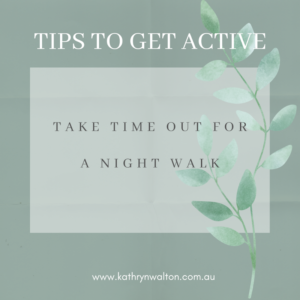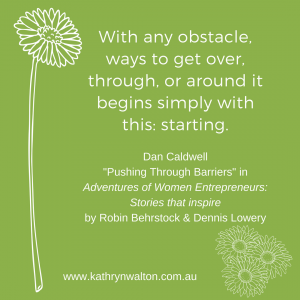Today we’re diving back into the topic of motivation which is always a very popular theme when it comes to anything that feels like hard work including exercise. I’ve previously written about how to get motivated for exercise so this time we’re going to explore motivation from a different but related perspective – how to get motivated to get outdoors more often.
The outdoors can help you get more movement into your day
The thought of exercise can be overwhelming. Some people really don’t like it and some people struggle to get into a regular routine because of health, mobility or medical issues. Perhaps you’re one of them. Or maybe there’s another reason that you struggle with exercise. But ….. did you know that the most important thing – even more than exercise – is movement?!
Exercise is fabulous for so many reasons, and yes, I’m passionate about this topic, but it’s absolutely critical that exercise is built on a strong foundation of general movement right throughout the day. Here’s where nature can help you if you struggle with either exercise, or generally being active and moving around more. When you include contact with nature in your daily routine, you’ll get outdoors more often, move more, sit less, and you’ll find joy in life and joy in connecting with nature. Your body will also benefit from the boost of Vitamin D it gets when you get outside into the sunshine.
Find your own reason to get outdoors
If you do find it difficult to get outdoors and into nature, even though you know it’s good for you, try to find another reason or a purpose for going outside. It’s much better to feel positive and drawn towards it than feeling like you ‘should’ or ‘have to’.
Grow potted plants or a garden
 You could try growing some plants in pots or in a garden if you have enough space. Or you could have a go at growing salad greens and herbs in your kitchen. Plants can give you a reason to get up and get active when you look forward to nurturing and harvesting them. Checking on your plants every day gets you into a habit of connecting with nature. It helps you to get a daily routine going. Over time you can watch your plant habitat expand and before you know it there’ll be insects, butterflies, birds, bees, frogs and even spiders all sharing the space with your plants (especially if they’re outside) which is a sign of a healthy micro-habitat.
You could try growing some plants in pots or in a garden if you have enough space. Or you could have a go at growing salad greens and herbs in your kitchen. Plants can give you a reason to get up and get active when you look forward to nurturing and harvesting them. Checking on your plants every day gets you into a habit of connecting with nature. It helps you to get a daily routine going. Over time you can watch your plant habitat expand and before you know it there’ll be insects, butterflies, birds, bees, frogs and even spiders all sharing the space with your plants (especially if they’re outside) which is a sign of a healthy micro-habitat.
Look Out and Up
If growing plants is not your thing, you can still look for another reason or purpose to get outdoors and connect with nature that’s meaningful for you. Even if going outside is not an option, you can create a routine of looking out a window, for example, at birds as they fly by. Perhaps they’re searching for food, nesting or calling out to each other. Or you can look up at the clouds and notice their movement. Clouds never seem to stay still. They constantly morph from one shape, colour and texture to another.
Nature Walks and Journals
Are you up for a little more activity than simply observing what’s around? You could aim for a daily walk to a nature strip or park and notice the changes in your surroundings each day. Some of them will be obvious, and others much more subtle. It can get you wondering what changes you’ll see tomorrow when you next come back. You can make a mental note of the changes, or you might enjoy keeping a journal of what you see and hear on your outings. In your journal you can use words, but you can also use images. You might like to take a series of photos of something growing or changing, or keep some audio recordings of the sounds you hear in nature.
Learn and Grow
Take your noticing and journalling one step further by tapping into the resources in your community or on the Internet so that you learn more about nature and the outdoors. You can use bird and plant identification apps and books, online interest groups such as the Outdoors is my Therapy Facebook Group, clubs and you can simply ask other people what they know about the things you’ve seen or heard.
Set Yourself a Challenge
Staying motivated with your habit of regularly getting outdoors can be helped along by setting a challenge for yourself. This could include committing to a daily garden check or recording the birds you see for a week. Set a specific time of the day to do this that will work for you. For example, if you’re usually up and about early or spend time winding down after a day at work in the late afternoon, these would be ideal times to do a bird check because that’s when many birds are most active.
Notice the Little Treasures That Tell a Story
 Don’t forget that the little things in nature can also help you get motivated to establish a daily routine of getting outdoors. Have you ever been the first person to walk through a cobweb as you explore the park or bushland? I certainly have! I don’t like the feeling of sticky cobweb across my face and the panic of wondering if there’s a spider clinging to my back, but I am constantly amazed at how the spider can rebuild the web overnight and there it is the next day, stretched across the same bit of walking trail.
Don’t forget that the little things in nature can also help you get motivated to establish a daily routine of getting outdoors. Have you ever been the first person to walk through a cobweb as you explore the park or bushland? I certainly have! I don’t like the feeling of sticky cobweb across my face and the panic of wondering if there’s a spider clinging to my back, but I am constantly amazed at how the spider can rebuild the web overnight and there it is the next day, stretched across the same bit of walking trail.
If you find something like this in your local area whether it’s a cobweb, a little cluster of flowers, an ant hole, a tree with buds, a creek weir, or whatever it is, check on it every day to see what you can see. You will discover the secret life of the natural world all around you when you take a few moments to pause and notice.
Over time, these little discoveries will tell you a story. A story that will compel you to keep coming back day after day so you can see, hear, smell, taste and touch the next chapter.
What motivates you to get outdoors?
Some of us are motivated to get outdoors simply for health reasons. Some of us are not. But perhaps you will be motivated to see what’s calling for your attention outdoors once you get to know it better and discover nature’s secrets in your local neighbourhood. Too often we focus on the big, obvious things in life. I encourage you to focus on developing small habits – small changes to your routine. Look for the little treasures and let the motivation flow in its own time.
If you would like more motivation and inspiration to connect with the outdoors, subscribe to my newsletter Grounded Inspiration.
Listen to the audio version of this post in the Outdoors is my Therapy Podcast Episode 25!
 Discovering mountain biking as life’s ultimate parallel universe in her middle age, Kathryn Walton shares information and reflections that inform, inspire and empower women to a healthy and active lifestyle.
Discovering mountain biking as life’s ultimate parallel universe in her middle age, Kathryn Walton shares information and reflections that inform, inspire and empower women to a healthy and active lifestyle.











 “Adventure” is a word that repels many people, yet it’s the process of working towards an adventure goal that fills me with excitement and energy for the future. Adventure isn’t always fun and games. It can be pretty hard work too, with frequent floods of sweat, tears and frustration. So what’s the attraction? Why does anyone need to have an adventure
“Adventure” is a word that repels many people, yet it’s the process of working towards an adventure goal that fills me with excitement and energy for the future. Adventure isn’t always fun and games. It can be pretty hard work too, with frequent floods of sweat, tears and frustration. So what’s the attraction? Why does anyone need to have an adventure 











 time I respect them. I teach many individuals and groups how to use goals to enhance their mental health and wellness, and I see amazing progress when they are used effectively.
time I respect them. I teach many individuals and groups how to use goals to enhance their mental health and wellness, and I see amazing progress when they are used effectively. 
 Remember all those problems your mind started to thinking about in Step 2? Problem-solving is where the power is (another blog later this month will look at this in more detail). Persistence makes all the difference between giving up on your goal (and yourself) and being unstoppable. Some of the problems will be predictable and you’ll be able to plan for them. Others less so.
Remember all those problems your mind started to thinking about in Step 2? Problem-solving is where the power is (another blog later this month will look at this in more detail). Persistence makes all the difference between giving up on your goal (and yourself) and being unstoppable. Some of the problems will be predictable and you’ll be able to plan for them. Others less so. In the meantime, if you haven’t already signed up for Grounded Inspiration, now’s a great time to do that. Never miss out on the latest news, inspiration or blog posts! And be the first to hear about my new releases throughout the year as I develop and publish programs to enhance women’s wellness and professional knowledge.
In the meantime, if you haven’t already signed up for Grounded Inspiration, now’s a great time to do that. Never miss out on the latest news, inspiration or blog posts! And be the first to hear about my new releases throughout the year as I develop and publish programs to enhance women’s wellness and professional knowledge. 
 further afield to step into our beautiful Australian bush country! As I’ve traversed the trail over the past few months, I’ve sometimes stopped to look at the rock garden and visualise myself riding through the narrow gaps between the rocks without clunking my pedals. I knew that I would need to develop a lot more skill, line accuracy, confidence and power to ride this section. Basically I’d been riding it so slowly that I didn’t have enough power to get over the craggy rocks. Although I enjoyed my brief little fantasies of riding effortlessly over and around the rocks, I certainly didn’t have much hope that I’d ever actually be able to do it.
further afield to step into our beautiful Australian bush country! As I’ve traversed the trail over the past few months, I’ve sometimes stopped to look at the rock garden and visualise myself riding through the narrow gaps between the rocks without clunking my pedals. I knew that I would need to develop a lot more skill, line accuracy, confidence and power to ride this section. Basically I’d been riding it so slowly that I didn’t have enough power to get over the craggy rocks. Although I enjoyed my brief little fantasies of riding effortlessly over and around the rocks, I certainly didn’t have much hope that I’d ever actually be able to do it.  about something that was upsetting me. I wasn’t very mindful of where I was or what I was doing. Suddenly I realised I’d already ridden through the rock garden! I hadn’t dabbed my foot, I didn’t jab my pedals, and the smooth flowy feeling hit the pit of my stomach and came out of my mouth with a loud shriek, my previous upset forgotten in a moment of elation as I realised what I’d done. I’d accidentally got it right!
about something that was upsetting me. I wasn’t very mindful of where I was or what I was doing. Suddenly I realised I’d already ridden through the rock garden! I hadn’t dabbed my foot, I didn’t jab my pedals, and the smooth flowy feeling hit the pit of my stomach and came out of my mouth with a loud shriek, my previous upset forgotten in a moment of elation as I realised what I’d done. I’d accidentally got it right! Today as I walk the same trail and peer along the rock garden, I can clearly see the line that I need to take on my bike. The rocks seem so much smaller than before, the gaps between them seem so much wider, and I realise just how powerful the images and thoughts in our minds can be.
Today as I walk the same trail and peer along the rock garden, I can clearly see the line that I need to take on my bike. The rocks seem so much smaller than before, the gaps between them seem so much wider, and I realise just how powerful the images and thoughts in our minds can be. Kathryn Walton shares information and reflections in Daisy Spoke that connect, inspire and self-empower women to make healthy choices for themselves.
Kathryn Walton shares information and reflections in Daisy Spoke that connect, inspire and self-empower women to make healthy choices for themselves.